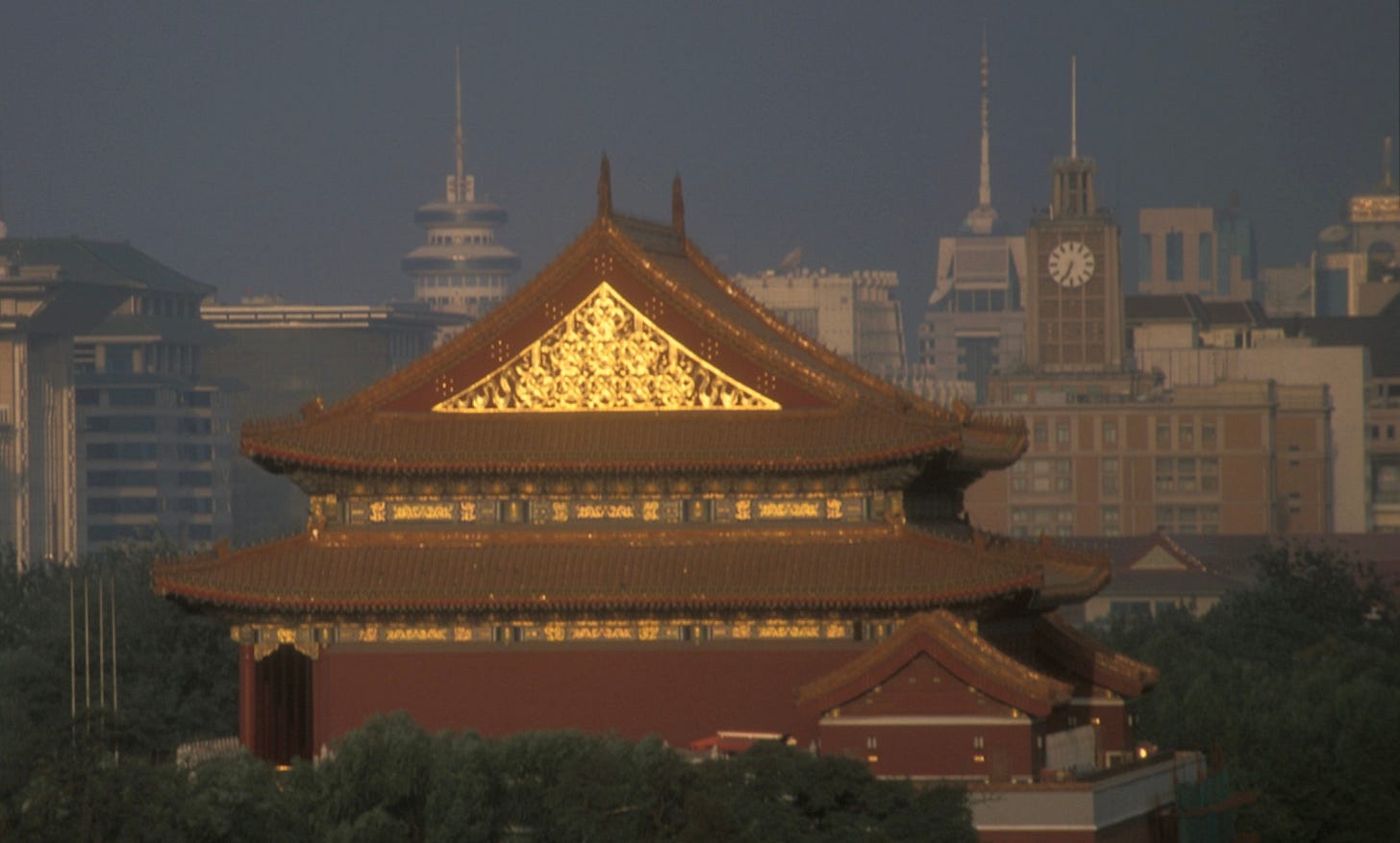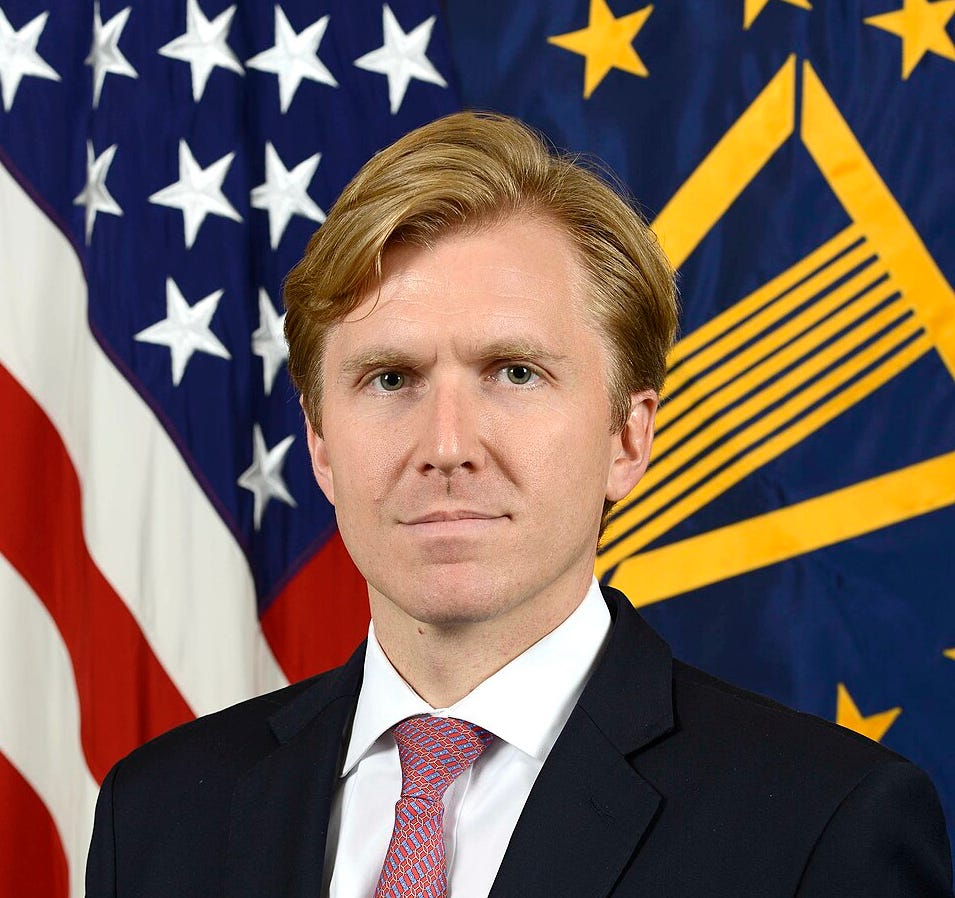Hello and welcome. This is the final in a three part series about America and its place in the world. Part one looked at America’s commitment to Europe. Part two was about whether and how to protect Ukraine, and today we’ll look at the US commitment to East Asia.
Happy New Year. Remember when we were gonna party like it’s 1999? Now we’re already a quarter century past that, and after all that’s already happened in the 21st century, it’s a natural enough spot to pause to survey what might happen next.
Content is free on CS&W. There’s no paywall, but if you like what you read I’d be grateful if you’d subscribe for $5 a month or $50 a year for 2025. You tip your bellboy, don’t you? Of course you do. I have probably approximately as much insight as him. Probably.
A famous mid-twentieth century map, now enshrined in every Chinese passport, asserts the historical rights of the People’s Republic of China (PRC) in the East China Sea. The so-called nine-dash line (in green on the map below) claims sovereignty over reefs, islands and huge swaths of sea, based on claims dating to 1368.
The Permanent Court of Arbitration in The Hague ruled the claim has no legal basis. The PRC stands by it, while its neighbors disagree.
William Lai, president of the Republic of China (ROC), America’s ally on the island of Taiwan 100 miles east of the PRC, toured his countries’ Pacific allies earlier this month, and it only took a week. He showed the flag in the Marshall Islands, Tuvalu, and Palau. The allies, combined population 89,000, may not be the exact three Taipei would choose, but then, there’s also the United States.
On the same trip Lai visited Hawaii and Guam and conferred with US House Speaker Mike Johnson and House Minority Leader Hakeem Jeffries via phone and video link, meetings he might just as well have held from his Presidential Office Building in Taipei.
The United States doesn’t officially recognize Taiwan. But it claims it will defend the island against mainland China, its largest trading partner behind only Canada and Mexico, with which it trades what amounts to over sixty percent of Taiwan’s entire GDP annually.
Why would it do that? What’s really going on here?
Boiled down, it’s about winding down the post-World War II Pax Americana, and the most pressing question in the world right now is whether a transition to this new world can be accomplished without war.
•
The victorious United States emerged from the Second World War aiming to promote global stability, economic order and freedom of navigation on the high seas. Its price was acceptance of the dollar as the world’s reserve currency; most of the world bought in, and that model has mostly prevailed since.
It’s time for a new model. The war ended eighty years ago. The United States today has no business claiming it can defend Europe against Russia and Taiwan against China at the same time. It surely can not, and it must stop acting as if it can.
For many years Washington’s strategy of studied ambiguity - with its NATO allies in Europe and Taiwan in Asia - served it well against weaker challengers. But today’s new realities require a new approach.
The United States must engage in steady, determined, unwavering coordination with allies, European and Asian, to introduce a crucial - and prominently trumpeted - new understanding: a public, on-the-record declaration that America’s current security commitment is finite.
The aim would be twofold: to acknowledge and attempt to accommodate new players in a changing world, and to maintain the current peace while plainly leveling with the allies that there is no room for them NOT to step up.
•
Where are we now? In 2020 Chinese President Xi used a Central Committee plenum, then in 2022 a Party Congress to challenge his People’s Liberation Army to become a “world-class” military capable of winning regional wars by 2027, the 100th anniversary of its founding. Since “regional wars” obviously implicates Taiwan, many in the west have taken to predicting war in the straits in 2027.
(Not coincidentally, Japan’s ruling Liberal Democratic Party claims it will commit two percent of its GDP to defense spending by 2027, an initiative by former PM Fumio Kishida that may or may not be realized.)
The Obama administration announced an American ‘Pivot to Asia’ in 2011 but it did little to make it so, and nor did the first Trump administration. In the last four years the Biden team has seeded the ground for future regional alliances with a flurry of new initiatives. Now it’s time for the incoming Trump II administration to try to move the process forward.
You can’t see China from Taipei but I bet you can feel it. Maybe twelve million people up and down the shore opposite Taiwan, eighty miles away. The entire shoreline thrumms with what? Both sides’ Chineseness?
Imagine the tragedy of a civil war, a civilization in conflict, bombs across the strait on Taipei, but also back the other way onto the thriving Chinese port of Xiamen, three and a half million strong, even possibly destruction in the Chinese showpiece cities of Shanghai and Nanjing.
Consider escalation to Japan and South Korea, or the Philippines and Guam. It’s an avoidable tragedy and it mustn’t be allowed to happen.
“A Taiwan emergency,” the late Japanese Prime Minister Shinzo Abe once said, “is a Japanese emergency.” The Biden administration set out to forestall emergencies, and for most of this year it could claim steady progress.
The US knocked its allies’ heads together until Seoul and Tokyo resumed high-level defense exchanges, restored each other to their respective trade whitelists, held an unprecedented number of summits and at least began talks on compensating South Korean victims of forced labor during Japanese colonial rule.
Yet 2024 ends in a Japanese muddle and with South Korea in chaos.
South Korea: During his two years in office, South Korean President Yoon Suk-yeol did more than just speak Washington’s language, he sang American Pie at the White House. He declared that he wanted the U.S.-South Korea alliance to be the ‘central axis’ of his country’s foreign policy.
Yet an act of political malpractice in early December left Yoon’s government a smoldering, dangerous - and now a few weeks later - lingering wreck.
Inveighing against an obstreperous opposition, Yoon attempted to declare martial law. His cabinet resigned en masse in protest. The National Assembly overturned his declaration six hours later. Yoon tried to walk back his actions but was impeached.
Then Yoon’s replacement was impeached. With the finance minister now doubling as both president and prime minister, South Korea’s Constitutional Court is reviewing Yoon’s impeachment, with 180 days to rule.
For now it’s unclear who, in fact rather than theory, is in charge of the military, or the country really, as chaos spreads.
And that’s not the only reason South Korea is in a tough spot. In the event of conflict over Taiwan the 28,500 US troops stationed in South Korea to help maintain peace with North Korea, an existential threat for Seoul, would suddenly have urgent business elsewhere. And the incoming American president suggests a fee of $10 billion a year to maintain America’s protection.
Japan: Since he became Japanese Prime Minister on October 1st, Shigeru Ishiba has done the near impossible. All by himself he lost his Liberal Democratic Party’s majority in an ill-considered snap election. Until election day on October 27th the LDP had held the majority in Japan for all but four of its 69 years.
Still, if Mr. Ishiba can regain his footing, the US seems to have a ready (if politically beleaguered) partner in Japan. Ishiba has explicitly called for an ‘Asian NATO.’
An Asian NATO is not going to happen, but it highlights a hopeful trend among Western allies - collaboration across regions. Japan, South Korea, Australia and New Zealand, for example, attended a NATO summit in 2022, then their defense ministers attended a NATO Defense Ministers’ meeting in Brussels. Over time, engagement among allies could add weight to initiatives like dissuading China from its ‘no limits’ partnership with Russia.
Ishiba has repeatedly advocated for revising the Japan-U.S. Status of Forces Agreement to allow Japanese forces to station in Guam. He has advocated for a “nuclear sharing” agreement with the U.S. and he talks about Japan’s need for security autonomy and strengthening the bilateral alliance “to the same level as the U.S.-U.K. alliance.” All of which should be music to US military planners’ ears.
The Philippines: Bilateral relations during the concurrent 2017—2021 administrations of Donald Trump and Philippines’ President Rodrigo Duterte largely comprised theatrical posturing by unserious men. The Biden administration has more effectively aligned the two countries’ defense postures, working with current President Bongbong Marcos.
The US has secured access to nine bases in the Philippines as part of the Enhanced Defense Cooperation Agreement (EDCA) which Rodrigo Duterte put on hold while the Filipino president did an ineffectual China dance. The EDCA allows Filipino and U.S. troops to cohabit on Philippine bases. The two countries have explicitly reaffirmed their mutual defense treaty, and conducted around a half dozen joint exercises in 2024.
(Yet the unserious Dutuerte family still lurks: The Philippines’ vice president is Rodrigo’s 46-year old daughter Sara, who has publicly threatened to have President Marcos assassinated.)
Vietnam is a player here, too. Hanoi won’t be forgetting that the 1979 Sino-Vietnamese War, a month-long conflict that killed perhaps 30,000, was China's most recent full-scale invasion of another country.
Letters between the Filipino and Vietnamese Defense Ministers in August pledged tighter agreement on military cooperation. They “aimed to sign” a formal agreement before the end of the year but as far as I can tell that is still pending.
When Joe Biden visited Hanoi in September the United States and Vietnam claimed a new “Comprehensive Strategic Partnership” involving diplomatic frills that probably don’t mean much, but in practice seem to involve more contact at the foreign ministry level.
The Greater Pacific: The United States has some diplomatic catching up to do. Two years ago China and the Solomon Islands signed a security agreement allowing for deployment of Chinese military personnel to the archipelago and permitting Chinese ships to call at Solomon Island ports.
Chinese engagement with the Solomons’ capital Honiara, just a thousand miles northeast of Cairns, caught Australia unawares. Since then a $190 million security arrangement between Australian PM Anthony Albanese and Solomon’s leader Jeremiah Manele, meant to beef up the Solomons’ police force, has not shaken loose an undisclosed number of Chinese advisors.
The initial news sent US Secretary of State Antony Blinken scrambling off on a slapped-together meeting in Fiji that February with 18 Pacific leaders, most attending online. It was the first visit to Fiji by a US Secretary of State since 1985.
Feigning to be first and foremost focused on Pacific island affairs was tough. Blinken wanted to be anywhere but Nadi just then, because February 12th, 2022 was twelve days before Russia invaded Ukraine.
Blinken looked forlorn, an early instance of a now familiar pose, standing alongside the acting Fijian Prime Minister in Fiji, lamely promising to open a new embassy … in the Solomon Islands.
Chinese diplomacy is active elsewhere in the region. Luganville, Vanuatu’s second city, on the island of Espiritu Santo, has a shiny new, controversial, Chinese built port. (I addressed the Luganville pier in an article here after a visit.)
The Luganville wharf’s stated purpose is to host cruise ships, but it’s big enough to service naval vessels too. An Australian security analyst called the wharf “overkill” for the cruise industry. I checked and I could only find 61 cruise ship arrivals scheduled for 2023 in all of Vanuatu.
(Building a port for cruise ships could be good for China even if it really were just for cruise ships. The worry is that China could move on Vanuatu as they did at the Hambantota port in Sri Lanka, in what analysts call “debt trap diplomacy.”
The port on Sri Lanka’s southern coast was built with loans from a Chinese state-owned bank and opened in 2010. But when the Sri Lankan government struggled to pay its debt, under a 2018 deal Chinese firms emerged with a 70 per cent stake and 99 year lease.)
The US has been active elsewhere in Oceania. In 2023 Washington signed agreements with the Marshall Islands and Palau, assuring American warships may continue to call. Palau in particular, east of the Philippines, grants the U.S. exclusive military access to its territory.
Early last year the US and Papua New Guinea hammered out a similar access agreement, the State Department claiming it would “improve the capacity of Papua New Guinea's Defense Force and increase stability and security in the region.”
President Biden was due to become the first US president to visit PNG but cancelled because of a budget crisis back in Washington. Blinken flew off to consummate the agreement with PNG Prime Minister James Marape. It grants U.S. forces access to the country’s airfields and ports and authorizes the U.S. Coast Guard to patrol PNG waters and board foreign vessels.
Here is a map of this Pacific moment, Chinese influence in red, US influence in blue.
What happens next? To paraphrase Donald Rumsfeld, you live with the president you’ve got, not the president you’d wish to have. The US’s Job One through the first half of the incoming Trump II administration should be to poke, probe and push for concrete collaboration from allies.
For all of today’s unhealthy muscle-flexing in East Asia, powerful disincentives exist for US/China conflict. China is likely uneasy about Russia and North Korea’s budding collaboration. Rapid economic growth and the overlapping trade relationships that sped China’s rise may have enmeshed other Asian countries in such a web of trade by now that nobody wants to upset the apple cart. There are even voices urging a rekindling of the love affair between Donald Trump and Kim Jong Un.
Power dynamics are on fast forward toward change just now in East Asia, and in the meantime the United States isn’t going away. Next month brings back Donald Trump’s brand of bluster and brinksmanship. The new administration comes armed with the eighteen hundred page, $895.2 billion National Defense Authorization Act that President Biden signed on December 23rd, which seeks to increase the US presence in the Indo-Pacific. Cristina Maza reports in National Journal that this year’s NDAA:
‘establishes a fund to allow American arms to flow to Taiwan through purchases made directly from private industry. It authorizes nearly $10 billion to the Pacific Deterrence Initiative, a program to support partners and enhance US military infrastructure and military readiness in the region. It authorizes the Pentagon to provide $300 million in military equipment and training to Taiwan and ‘requires the Defense Department to devise a plan to establish a joint force headquarters in Japan, which would operate under the U.S. Indo-Pacific Command.’
The incoming Defense Department policy chief is the grandson of former CIA Director William Colby, 44 year old Elbridge (call him ‘Bridge’) Colby. His clear priority is to deploy US military resources away from the Middle East and Europe toward the Pacific.
Meanwhile enough Republican Congress members now seem eager enough to abandon Ukraine that with their help, Barack Obama’s pivot to Asia, fourteen years on, may reach critical mass.
•
This series has urged the United States to explicitly declare its intention to pull back from its more flamboyant commitments as guarantor of the world’s security. America should insist on steady, determined allied burden sharing, explicitly declaring that its security commitment is finite and that it intends to pull back over time.
As a huge, rich, powerful country, America should continue to carry much of the load alongside its allies, all the while wielding its considerable soft power, educating promising young minds in US universities, investing in infrastructure in the developing world, and continuing to be the world’s most effective first responder to disasters.
America’s strategic priority in the East China Sea for 2025 is to make explicit its intention to hand over responsibility for regional security to regional actors over time. It should work to more formally codify new security arrangements with its regional allies so that in the event of conflict with China, allied forces know what to do and can get to doing it promptly without duplication of effort.
There is at least some chance that good sense will prevail. It’s possible. Let’s see.
•
You spent a hundred dollars at the grocery store on products from Tyson Foods and Johnson and Johnson and Georgia Pacific and Kraft Heinz and General Mills and so you haven’t heard back from any of them that they appreciated your business.
If you find CS&W more intellectually stimulating than Kaboom or Febreze, consider that I’ll appreciate your contribution more than Mr. Proctor, Mr. Gamble, their heirs, the Colonel, Wendy, all Five Guys or the Big Boy. Thanks for reading this column and Happy New Year.













